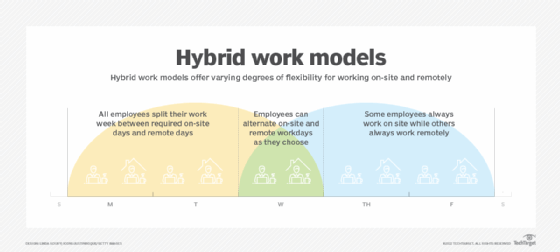Best practices to build a sustainable hybrid work model
Discussing employee preferences well before setting policy, and carefully analyzing team collaboration needs and technologies can ensure that the hybrid model works for everyone.
One of the biggest lessons that organizations have learned coming out of the pandemic is that employees like being able to decide where and when they work. While many tasks -- especially those involving collaboration between colleagues -- are best performed in person, the flexibility that a hybrid work model offers is attractive to people seeking a healthy work-life balance. As companies experiment with launching and managing their hybrid work models, there are some best practices to consider.
1. Involve employees in hybrid work model development
Organizations often start developing their hybrid work models in discussions about policy, such as how many days per week employees are expected to work on site, and rules about when they should be available to their colleagues when working remotely, according to Ben Wigert, director of research and strategy in the workplace management division at the Gallup research firm, headquartered in Washington, D.C. Wigert said a better approach is first focusing on individual contributors and teams and designing a model that takes their needs into account.
"The organizations I work with that are having the most success are putting a lot of emphasis on making sure the team and the manager have a strong conversation about what they need, from a collaboration standpoint and an individual contributor standpoint," Wigert said. During these discussions, talking points may include the following:
- What are our goals?
- How do you best work independently?
- How do we best work together?
 Ben Wigert
Ben Wigert
"When they have a clear conversation about that, we actually see a boost in engagement," he said.
This isn't to say policies aren't necessary. In some cases, organizations may opt instead to establish a set of somewhat flexible guidelines for hybrid work instead of a strict policy, according to Wigert. Whatever the case, he encourages companies to adopt an iterative approach to developing hybrid work models so they can make adjustments as time goes on.
This article is part of
Ultimate guide to recruitment and talent acquisition
"It should be a fluid process of figuring out what works," he said.
2. Determine how many days employees must work on site
There is no magic number of on-site workdays for a successful hybrid model, Wigert said, nor do certain days produce better results than others. At the same time, he said, Gallup is beginning to see success with hybrid work models that give employees a moderate amount of flexibility by allowing them to work remotely two or three days a week. He said arriving at this number largely depends on how much in-person collaboration time specific teams will require. He advised managers to consult with their employees to review their collaboration needs, as well as the needs of the organization and its customers.
"The people who are really suffering are the people whose jobs can be done remotely, but they're forced to be fully on site all the time," Wigert said. When companies mandate a fully on-site model, employee engagement and well-being diminish while turnover increases. "But a moderate amount [of time on site] gives them enough time in person to feel connected to their culture, and they can collaborate effectively with their team and also with other teams when needed."

3. Be fair to employees who must work on site
Not all jobs are what Gallup terms "remote capable," and some employees must work on site all the time. Robin Erickson, vice president of human capital at The Conference Board, a New York-based think tank, warns that when granting flexibility to remote-capable employees, it's necessary to take into account the needs of those who work exclusively on site.
 Robin Erickson
Robin Erickson
"Flexible programs can create feelings of unfairness and it can lead to friction between your on-site employees and your remote employees," Erickson said. She suggests companies compensate on-site employees for the lack of flexibility their positions offer. "If they're required to be on site, perhaps they should get something [like] an on-site bonus or something that other people don't."
Erickson also urged organizations to reach out to on-site employees to explore ways they can obtain more flexibility, such as the ability to be absent on Friday afternoon, for example. "Get them involved and have them help you think about what employees really want and really need," she said. "If you engage them in the process, you'll have fewer feelings of unfairness."
4. Accept that hybrid work requires more coordination
Wigert said one of the biggest challenges associated with hybrid work is that it requires managers and employees to spend more time on coordination. This means doing the following:
- taking the time to coordinate when people can and should be available to collaborate;
- figuring out which types of collaboration sessions should be conducted in person; and
- discussing which kinds of collaboration sessions can be done in a hybrid environment or all remote.
"The new layer for hybrid workers is not just 'when do we meet?' but 'do we meet in person or not, and why?'" Wigert said. "It may make us more intentional with our meetings, but because we're new to it, the challenge of hybrid is ambiguity and coordination because we've never had to coordinate in this way before."
5. Provide technology that helps employees get their work done
Technology should be a facilitator rather than a barrier to employees accomplishing their tasks. For this reason, Wigert urges companies to examine what technology is required for them to achieve a sustainable hybrid workflow. In many cases, this means investing in both on-site and remote work technology that will enable employees to perform well no matter where they happen to be working on any given day. This includes the following:
- outfitting conference rooms and collaboration spaces with videoconferencing systems that accommodate both kinds of participants equitably;
- providing scheduling tools so employees can easily book conference rooms and collaboration spaces when their teams will be meeting on site; and
- ensuring that employees have access to the equipment and applications they need to work effectively in a remote environment.
6. Create opportunities for informal connections
One of the biggest challenges in hybrid working environments is that employees don't have as many opportunities to connect with their colleagues spontaneously and informally. Wigert said because of this, companies need to work harder at encouraging employees to do things like having coffee or lunch together when they are in the same location.
"We need to build relationships a little bit more intentionally because we have fewer of those chance interactions," Wigert said.
 Dan Manian
Dan Manian
Dan Manian is co-founder and CEO of Donut, headquartered in New York, which offers a platform that enables workers to make social connections. Manian argues that because hybrid work models make relationship building more challenging, some employees may lose out on the chance to build friendships and advance their careers.
"You have this risk of creating inequitable opportunity for people to build relationships, and relationships lead to friendships but they also lead to opportunities to work on cool projects and opportunities to get promoted," Manian said. "Who you know in your organization matters on many, many levels."
This is why it's important, Manian said, to maintain the "virtual rituals" that many companies adopted during the pandemic, when everyone was working remotely. Oftentimes, these outlets invite employees to connect with one another about something other than work, such as online affinity groups where those with shared interests may interact virtually.
7. Prioritize feedback and development
By definition, a hybrid work model has people working from different locations. Because of this -- and due to the amount of coordination sustaining a hybrid work model requires -- Wigert said managers are spending less time on giving feedback, mentoring employees and providing career guidance. To give every employee an equal opportunity to further their career, he said companies must get better at delivering feedback and offering development opportunities.
"Feedback and development is what's behind inclusivity and diversity and equity -- it starts there," Wigert said. "You never even make it into the leadership pipeline or the promotion pipeline without coaching and feedback and early development opportunities."
Wigert emphasized that a hybrid work model should not invite employees to work anywhere they want, all the time. He does, however, say that offering employees some flexibility to work when and where it's convenient for them -- at least some of the time -- results in higher engagement, more productivity and an increased level of well-being. The questions companies should be asking, then, are: What is the right amount of flexibility for us? For our teams? For individual contributors?
"If you figure that out, your talent retention is going to be better, your productivity is going to be better and people are going to be healthier and happier with your company," Wigert said. "And in a world where it's just an absolute war for talent right now, I don't think you can afford to look the other way on that truth."







